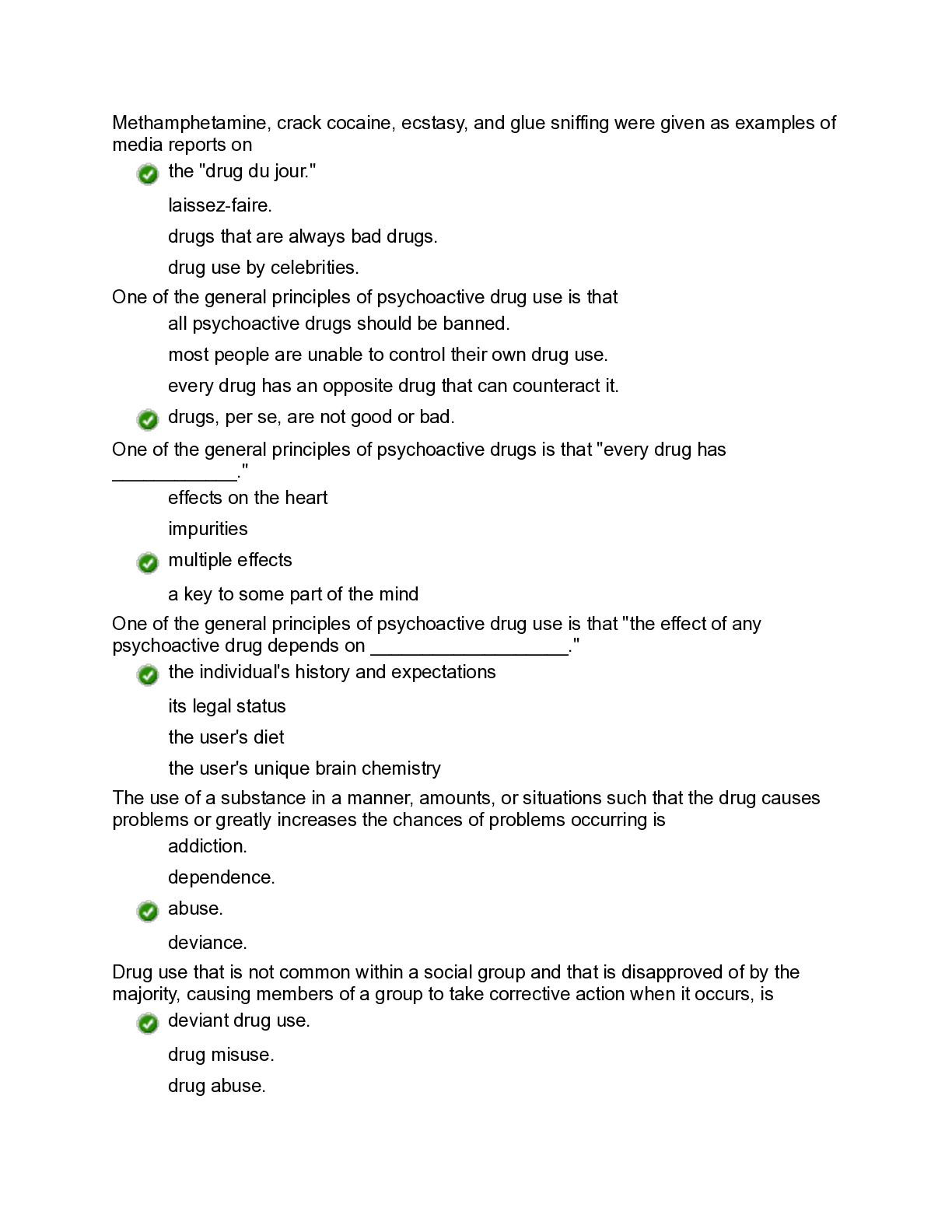Physiology > QUESTIONS & ANSWERS > Camden County College PSY 101:14: PSYCHOSOCIAL DEVELOPMENT IN YOUNG ADULTHOOD (All)
Camden County College PSY 101:14: PSYCHOSOCIAL DEVELOPMENT IN YOUNG ADULTHOOD
Document Content and Description Below
Answer:A Page: 493 Guidepost: 1 Type: C 1. Which model of personality development assumes the least amount of personality change in adulthood? A. Trait model B. Humanistic model C. Timing-of-e... vents model D. Normative-crisis model Answer:D Page: 493 Guidepost: 1 Type: C 2. A sequence of age-related development that continues through the adult life span, identified by major, predictable life changes, describes the A. Five-factor model B. Humanistic model C. Timing-of-events model D. Normative-stage model Answer:C Page: 493 Guidepost: 1 Type: C 3. Which personality model focuses on mental, emotional, temperamental, and behavioral attributes? A. Timing of events model B. Humanistic model C. Trait model D. Normative-crisis model Answer:C Page: 496 Guidepost: 1 Type: F 4. Which of the following is not a personality trait included in the five-factor model? A. neuroticism B. extroversion C. satisfaction D. agreeableness Answer:D Page: 497 Guidepost: 1 Type: C 5. The five-factor model of personality emphasizes A. personality changes that occur during middle adulthood B. five crises that adolescents and young adults experience that produce instability in personality C. normative influences on adaptive mechanisms in mid-life D. stability of personality characteristics over much of adult life Answer:C Page: 498 Guidepost: 1 Type: F 6. Which of the following is not a personality type that reflects the typological model of personality? A. ego-resilient B. overcontrolled C. conflicted D. undercontrolled 238 Answer:D Page: 493 Guidepost: 1 Type: F 7. Currently, developmentalists who ascribe to the normative-crisis model believe that people A. experience no further development after adolescence B. continue to develop through their thirties, but undergo only minimal changes thereafter C. probably develop very little after age 50 D. continue to develop throughout life Answer:A Page: 493 Guidepost: 1 Type: F 8. Which model describes human development as a universal sequence of age-related social and emotional changes? A. normative-crisis B. normative age-graded C. normative history-graded D. timing-of-events Answer:C Page: 494 Guidepost: 1 Type: C 9. Dr. Dunn says that she supports Erik Erikson’s model of development which assumes that people pass through a universal sequence of age-related social and emotional changes during the life span. According to the text, Dr. Dunn supports the __________ model. A. idiosyncratic stage theory B. normative-sequential C. normative-crisis D. nomothetic-longitudinal Answer:C Page: 494 Guidepost: 1 Type: C 10. Bill, age 30, is searching for the right woman to share his life and future. He would be at Erikson’s stage of A. identity versus identity confusion B. industry versus inferiority C. intimacy versus isolation D. initiative versus guilt Answer:B Page: 494 Guidepost: 1 Type: F 11. According to Erikson, which of the following must people achieve before they can begin to form intimate relationships? A. mutuality of devotion B. a strong sense of personal identity C. generativity D. integrity Answer:B Page: 494 Guidepost: 1 Type: C 12. A young woman passes through adolescence without developing a strong sense of personal identity. According to Erikson, what difficulty will she experience during young adulthood? A. She will lack competitiveness. B. She will have problems with intimacy. C. She will become sexually promiscuous. D. She will fail to develop “the dream.” Answer:A Page: 494 Guidepost: 1 Type: C 13. Susan and Paul are young adults who have developed a high level of intimacy and commitment toward one another. They will marry soon. According to Erikson, Susan and Paul have developed A. mutual devotion B. the virtue of compatibility C. the virtue of trust D. generativity Answer:D Page: 494 Guidepost: 1 14. Aspects of Erikson’s theory that have been criticized include all but which of the following? A. The only lifestyle he considers healthy is a loving heterosexual relationship 239 Type: F that produces children. B. He focuses on a male pattern of development. C. The theory assumes homosexuality is not normal. D. He places too much emphasis on sexual strivings. [Show More]
Last updated: 2 years ago
Preview 1 out of 16 pages

Buy this document to get the full access instantly
Instant Download Access after purchase
Buy NowInstant download
We Accept:

Reviews( 0 )
$9.00
Can't find what you want? Try our AI powered Search
Document information
Connected school, study & course
About the document
Uploaded On
Aug 10, 2021
Number of pages
16
Written in
Additional information
This document has been written for:
Uploaded
Aug 10, 2021
Downloads
0
Views
105



.png)





.png)



